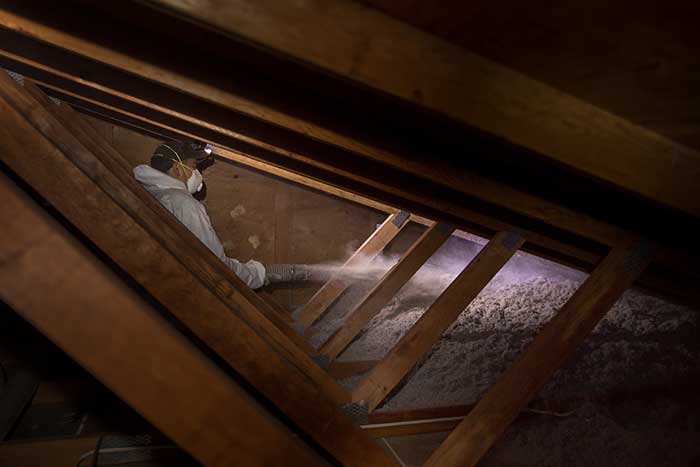Although there are many insulation types out there, Northwest homes are best suited for attic insulation designed to meet our cool, wet and humid winters and dry summers. Read more to find the best attic insulation for your home.
If you’re trying to save money on your home energy bills, you may be using your home’s heating and cooling systems less. But did you know that there’s a much better (and more comfortable) way to save money and keep your home at the ideal temperature?
Believe it or not, installing reliable attic insulation is your ticket to lower bills and more efficient temperature control. Curious to learn more?
Keep reading for more information about the benefits of attic insulation and for a full breakdown of the different insulation types available. Let’s get started!
Why Attic Insulation Matters
Attic insulation plays a huge part in keeping your home warm during the winter and cool during the summer. Think of it this way: heat rises because hot air molecules are less dense, right?
So, when the heat releases from your wood stove, furnace, or boiler, it travels upward in your home. If your attic isn’t insulated, you can say goodbye to all that precious heat and the money you spent on it.
Conversely, attic insulation will also help keep your home cool during the hot summer months. Without the right insulation, hot air will seep through the open cracks of your attic and make its way into the rest of your home.
Properly installed insulation is the only way to ensure that your home’s temperature control systems work efficiently and correctly.
Different Attic Insulation Types
To choose the best insulation for your home, you’ll need to understand the three most common types of attic insulation that are available. Let’s break down each option with pros and cons.
Fiberglass
As its name suggests, fiberglass consists of plastic that’s reinforced by many tiny glass fibers. It comes in two forms, blankets and rolls.
Pros:
- It’s relatively inexpensive
- If you have even a little experience, you can install it yourself
Cons:
- It only works well in standard, unobstructed spaces
- Fiberglass particles are dangerous for humans and can cause rashes, eye irritation, throat and nose irritation, and stomach irritation
- Fiberglass traps dust and moisture particles, creating a hotbed for mold growth
- To handle fiberglass, you’ll need to wear full safety gear (goggles, gloves, long-sleeved shirt, and long pants)
How to Install
If you’re brave enough to install fiberglass yourself, follow these steps. But keep in mind that only experienced handymen and women should handle this type of task.
- Put on your safety gear
- Measure the length and width of your first piece needed, adding an inch on each side to make sure it’s a snug fit
- Put the insulation down on a piece of junk plywood
- Mark the measurements on your insulation with an easy-to-see marker
- Use a straightedge to create a cut line along the first measurement
- Carefully glide a utility knife along the straightedge (you may need a long blade if the insulation is thick)
- Put the trimmed insulation inside of the intended cavity
- If the cavity isn’t full, use another piece of insulation on top of the first
- Repeat this process until the attic is fully insulated, working toward the exit so as not to become trapped
Spray Foam
Spray foam is a type of floor and wall insulation composed of two different chemicals, polyol and isocyanate. When these chemicals come in contact, they can expand to over twice their size.
Pros:
- It doesn’t absorb water, preventing mold growth
- It’s flexible and can settle into any nook or cranny
Cons:
- It’s relatively expensive
- It involves a complex installation process
- Some types of spray foam insulation have a bad odor
How to Install
Spray foam installation requires professional help. Don’t attempt this installation process by yourself.
Cellulose
Cellulose is a tried-and-true method of home insulation. Most often, it’s made of recycled materials like denim or newspaper. The insulation is most often blown-in.
Pros:
- Cellulose is a sustainable and environmentally-friendly material that you can feel good about having in your home
- The borate treatment in this insulation makes it resistant to pests, mold, and fire
- It covers hard-to-reach areas with ease
- It’s the most affordable option for insulation
- Installation is simple and doesn’t involve harmful chemicals, irritating components, or greenhouse gases
Cons:
- Cellulose is a heavy material compared to fiberglass
- Homeowners will need to make sure their cellulose insulation stays dry
- It may need upkeep if settling occurs
How to Install
- Rent a machine to blow the cellulose insulation into your attic
- Grab a friend who can help you (installation is difficult alone and can get messy)
- Get proper safety equipment including breathing masks
- Put on some clothes that you don’t mind getting dirty
- Load each bag of cellulose into the machine, turn it on, and blow the insulation evenly over the entire surface of the attic
Feeling Overwhelmed?
If you’re overwhelmed by the thought of installing insulation yourself, don’t panic. Just call the pros to get the job done for you. To find a trustworthy company in your area, look for glowing customer reviews.
What’s the Best Insulation for Attics?
So, which of these options is the best insulation for an attic or loft? Well, that’s up to you.
Every home and family are different. The material that you choose to use in your home depends on your preferences and budget.
We whole-heartedly recommend cellulose as our top choice for attic insulation. It’s kind to both the environment and your wallet. Cellulose provides excellent insulation while keeping your family out of harm’s way.
Wrapping Up
Installing attic insulation is a great way to keep your home warm in the winter and cool in the summer. It will also keep your energy bills low year-round.
If you want to experience these benefits, use the information about different attic insulation types above to make the right choice for you and your family. And remember, we always recommend contacting a professional for insulation installation. They’ll make sure the job gets done efficiently and safely.
Do you have any questions about finding the best insulation for you, or would you like to learn more about us and what we do? Contact us today for more information or a free consultation. We’d love to hear from you!

